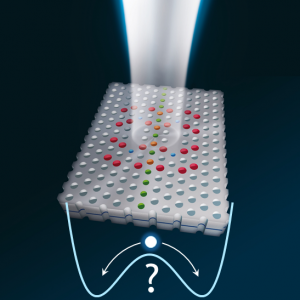A Better Understanding of Symmetry Breaking
In an international collaboration, AMOLF researchers have theoretically described and experimentally observed spontaneous symmetry breaking (SSB) in two laser-driven coupled optical cavities. SSB is a universal phenomenon that occurs in many physical systems. It is at the heart of the laser, superconductivity, and the Higgs mechanism, for example. In the case of laser-driven systems like optical cavities, it was not yet understood how SSB occurs. Because laser-driven systems are always in a state imposed by the laser, the nature and manifestation of SSB is completely different from other systems.
The AMOLF group was initially competing with groups in France and New Zealand to realize SSB in laser-driven coupled optical cavities, but at a certain point they decided to team up. Their joint effort resulted in a clear first demonstration, and thorough theoretical understanding, of SSB in laser-driven coupled optical cavities. They published their findings in Physical Review Letters on February 4th.
A little over two years ago, Said Rodriguez met Alejandro Yacomotti, a former colleague from his postdoc time in France, at a conference. They realized that they were both working towards the same goal. “Yacomotti’s group was more advanced experimentally, while we were ahead on the theoretical modelling”, says Rodriguez. “We decided not to compete, but to join efforts. I reckoned there is no point in doing things twice, when we could do it once and better together.”
Spontaneous symmetry breaking
Symmetry is abundant in physics and has helped scientists to gain insight into the laws of physics ever since the earliest natural philosophers. Symmetry in a system can be broken explicitly by an applied force, but also spontaneously by tiny fluctuations. How and when this happens is investigated in many fields of physics. Rodriguez: “Imagine a perfectly cylindrical stick, standing upright. If we exert an evenly distributed force on top of such a stick, it would hold for a while. But, with increasing force, a tiny fluctuation can break or bend the stick, such that the system would no longer be symmetrical. This is a form of spontaneous symmetry breaking.”

Coupled cavities
Together with his colleagues in France and New Zealand, Rodriguez and his team worked on an optical system that is symmetrical by nature: a set of two optical cavities driven by a coherent laser. Laser-driven coupled optical cavities are intensely investigated in many research labs because they are the building-blocks of various optical information processing technologies. “In the laser itself, we see a classic case of SSB”, he explains. “Lasing requires a critical pump threshold, above which the emitted light has a well-defined phase. The initial phase is selected spontaneously. All phase values are equally probable, but one is selected at random by tiny fluctuations; we then say that the symmetry has been broken spontaneously. Some years ago our French colleagues published a somewhat similar SSB demonstration in systems where the phase of the driving is irrelevant.”
Innovative thinking
Since then, several groups have been trying to understand how SSB occurs in systems that are driven coherently, for instance by a laser with a well-defined phase. The present publication is the first demonstration of SSB in such coherently driven systems. Rodriguez: “A system of coupled nonlinear optical cavities can have many states at a single driving condition. This makes it very challenging to observe SBB experimentally. The three groups in our collaboration brought in their own expertise and used different theoretical methods. It took some innovative thinking and a combination of these different approaches to advance the theory into new regimes, where the system chooses one of two distinct states at the SSB point, like a stick bending left or right under pressure. AMOLF PhD student Kevin Peters and master student Anne Spakman put in considerable efforts on this theoretical part. Our French colleagues carried out experiments in which SSB was indeed observed as an increased light intensity in one of the two coupled cavities.”
Sensitive sensing
Together with their international collaborators, the AMOLF team delivered a thorough and complete fundamental framework for understanding SSB in coupled optical cavities that has relevance in several areas of technology. “At the SSB point, light in the optical cavities becomes entangled and shows quantum behavior. The findings in this work might be relevant for quantum technology where a system like this could be a source of quantum light,” says Rodriguez.
His group at AMOLF is also interested in sensing applications of the new insights. “At the SSB threshold, a system of coupled optical cavities is very sensitive for small perturbations, e.g. caused by nanometer sized biomolecules entering the system. We can use the insights we have gained in this collaboration to refine our own experiments with slightly different optical cavities for sensing purposes.”
Reference
B. Garbin, A. Giraldo, K. J. H. Peters, N. G. R. Broderick, A. Spakman, F. Raineri, A. Levenson, S. R. K. Rodriguez, B. Krauskopf, and A. M. Yacomotti, Spontaneous symmetry breaking in a coherently driven nanophotonic Bose-Hubbard dimer, Physical Review Letters, 128, 053901, 4 February (2022).


